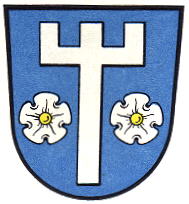Homburg am Main: Difference between revisions
Jump to navigation
Jump to search
Knorrepoes (talk | contribs) m (Text replacement - "{{de}}" to "") |
Knorrepoes (talk | contribs) m (Text replacement - "{| class="wikitable"↵|+Official blazon↵|-↵|'''German'''↵| ↵|-↵|'''English''' ↵| {{blazon wanted}}↵|}" to "{| class="wikitable" |+Official blazon |- |'''German''' | blazon wanted |- |'''English''' | blazon wanted |}") |
||
| Line 13: | Line 13: | ||
|- | |- | ||
|'''German''' | |'''German''' | ||
| | | blazon wanted | ||
|- | |- | ||
|'''English''' | |'''English''' | ||
| | | blazon wanted | ||
|} | |} | ||
Revision as of 08:09, 6 April 2023
HOMBURG AM MAIN
State : Bayern
District (Kreis) : Main-Spessart (until 1973 Marktheidenfeld)
Incorporated into : 1978 Triefenstein
| German | blazon wanted |
| English | blazon wanted |
Origin/meaning
Homburg developed around the castle of the same name and received city rights in 1332. The city was a fortress of the Bishops of Würzburg. The oldest seal dates from 1644 and shows already a fork and roses. The fork was used to catch otters in the Main river. The roses are derived from the arms of the Counts of Wertheim who ruled the city as vassals for the bishops.
Later the fork was mis-interpreted as a castle, resulting in the present shape.
Literature: Stadler, 1964-1971, 8 volumes; Hupp, O: Kaffee Hag albums, 1920s
